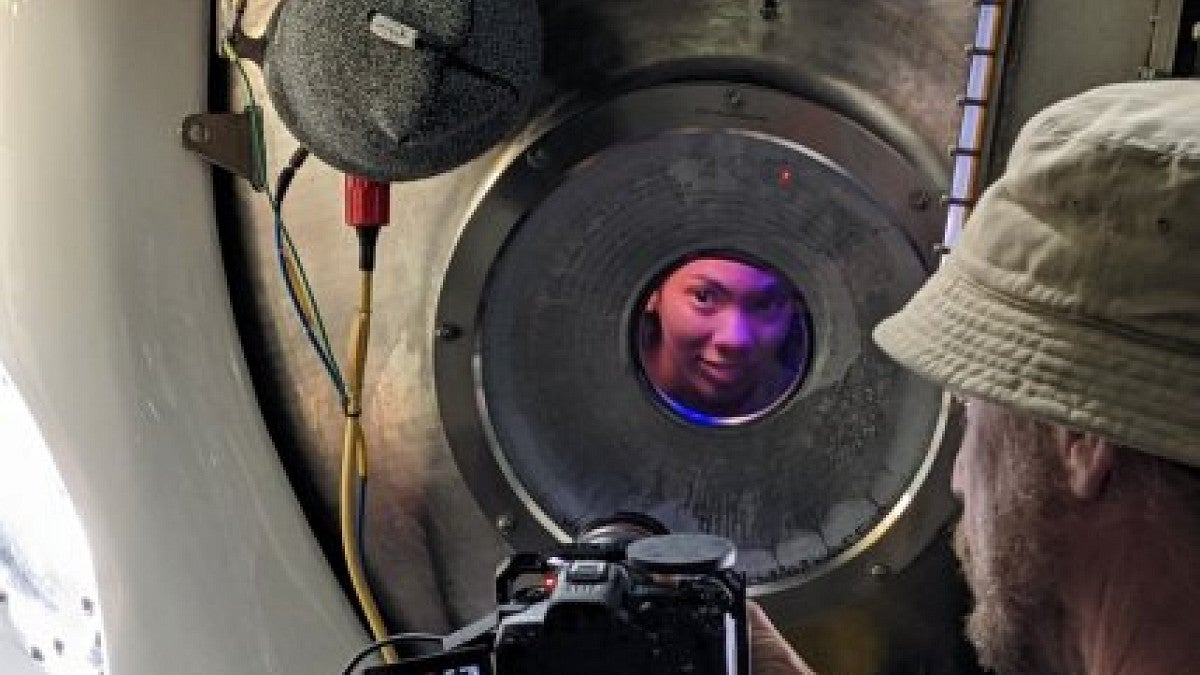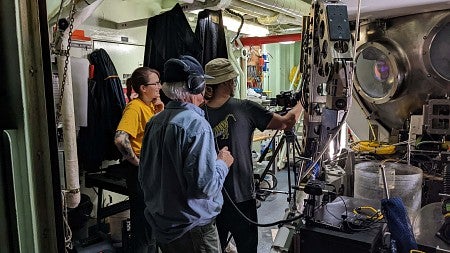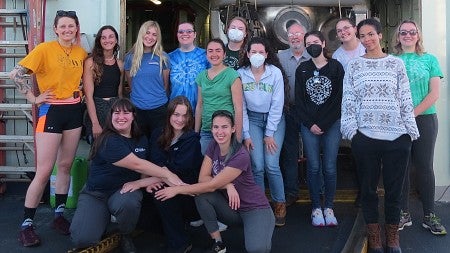
Experiential Learning | Research & Innovation | Community Impact | Career Preparation | Teaching Excellence | 21st Century Liberal Arts | Building Community | Good Vibes | CAS Spotlights | All Stories | Past Issues

January 8, 2024
Little Larvae to Hit the Big Screen
Growing up deep in the mountains of Colorado, Mel Lemke caught her early glimpses of the sea in IMAX films at the Denver Museum of Nature & Science.
Years later, she decided to study marine biology at the University of Oregon. During a deep-sea biology course, Craig Young, professor and director of the Oregon Institute of Marine Biology (OIMB) in the College of Arts and Sciences, made her an offer: He was leading a research cruise, and he had extra room.
Lemke said yes immediately.
“It’s also going to be an IMAX movie,” he added. Her response? “Even cooler.”
Born in the Abyss, planned for a 2024 release, tells the story of UO faculty and students conducting deep-sea larvae research along the East Coast. The film will highlight their fascination with these little-known wonders, with the goal of inspiring others to become involved in their discovery.
Documenting discovery
It all started with Alvin, the “most famous submarine in the world,” according to Young. Alvin helped find the sunken wreckage of the Titanic and discover deep-sea hydrothermal vents—hot springs where seawater and magma combine to enable a rare set of organisms to thrive without any sunlight.
The submarine underwent renovations in 2021, allowing it to go deeper into the ocean. Its next destination was Young’s research cruise to help his team collect data and gather observations. Filmmaker Stephen Low, who has a history of making films about the deep sea, was right behind.

In the fall of 2022, Young, a dozen or so other faculty and students, and a three-person film crew set sail from Pensacola, Florida, to the Louisiana coast and up the East Coast to Maryland.
Their research was focused on larvae, which Young defines as “little babies,” at methane seeps—areas where methane bubbles up from the seafloor and, like hydrothermal vents, creates the conditions for an ecosystem. The researchers were studying all the species of larvae they found there, but they were especially interested in the bright pink and magenta larvae of bathymodiolin mussels that dominate those areas.
During the voyage, the film crew interviewed the researchers and staged some shots. They filmed researchers zipping around the ship on a skiff, including a rare moment when students had the opportunity to touch the ocean—something the ship was too high to allow.
Mostly, the researchers went about their business as usual. While working long hours and going days without showering, they didn’t always feel camera-ready.
“You’re focused on the work, not on being a put-together human,” explains Caitlin Plowman, OIMB PhD candidate.
Showing what’s possible

With the filming complete, the film crew has now turned its attention to creating computer graphics. Low says this is “the hard, expensive, slow part.” But it’s also essential to help the audience understand how marine biologists study the deep sea.
That understanding, and the researchers’ fascination with their tiny subjects, are at the heart of the film.
Larvae are bizarre, beautiful, and “will capture a lot of imaginations,” says OIMB PhD candidate Lauren Rice. “I hope they inspire some people.”
But the IMAX film will capture more than the wonders of deep-sea larvae. It also has the potential to expose future generations of young women to new possibilities. Most of the researchers on the cruise were women, and Lemke emphasizes the importance of showing children the diversity of lives women can lead.
Looking back on her early exposure to IMAX films, she reflects, “it would have been really cool to see a bunch of young women working together on something amazing.”
Low adds, “There are young people doing incredible things, and they do so in part because they’ve seen that it’s possible.”
—Story by Vishva Nalamalapu, College of Arts and Sciences
